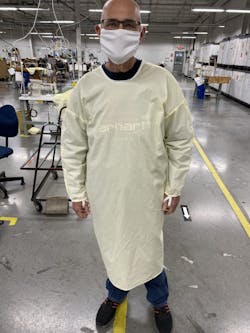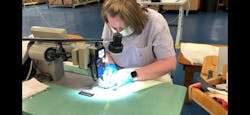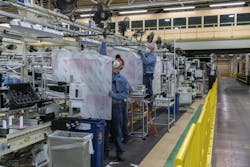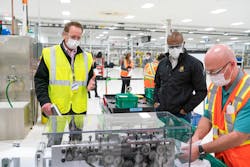The request came from out of the blue. Will Hardy, senior vice president of supply chain for workwear manufacturer Carhartt, was just wrapping up a day of corporate meetings addressing a plan of action around the COVID-19 emergency, when he got the call.
A medical gown manufacturer in Cincinnati was inundated with inquiries from hospitals and other first responders seeking protective gear for their frontline people. But the company couldn’t come close to meeting the demand. Could Carhartt, with its battalion of union sewers in nearby Kentucky, help manufacture gowns?
Hardy didn’t hesitate. “I said, ‘Sure, send a sample. We’d be more than glad to take a look at it.’” He wasn’t exaggerating: The 131-year-old company has a history of serving in national relief efforts. It manufactured uniforms, coveralls and camo for World War I and II soldiers, work clothing for “Rosie the Riveters” in the 1940s and thousands of bib overalls for rescue crews after 9/11.
Hardy had barely wrapped up that conversation when he fielded a second request. It was the Kentucky Department of Emergency Management, asking on behalf of the governor’s office if Carhartt could make masks.
Within 48 hours, Carhartt had a couple of workstreams set up to make gowns and masks. Regular production had already been shut down and workers sent home with pay, but some employees volunteered to return to make the protective gear.
Carhartt’s signature “brown duck” material wasn’t a fit for medical-wear, so Hardy’s team reached out to their regular suppliers, who helped source the necessary raw materials. Carhartt tailors also made some upgrades to the gown design, replacing string-tie fasteners in favor of Velcro, adding some tailoring work and offering more sizes.The first finished medical gown at Carhartt.
More than two months later, Carhartt is well on its way to manufacturing 50,000 medical gowns and 2.5 million masks, and is just beginning the first phase of transitioning to regular production. “I look back at how amazing it was—there was such grit and such resolve, by everyone that worked on this,” says Hardy. “We were all focused on doing the right thing.”
Carhartt is one of many manufacturers pivoting production to help with pandemic relief efforts while simultaneously changing their protocols, their physical footprint and their ways of doing business to keep from spreading the coronavirus. In Ohio, for instance, 19 manufacturers large and small collaborated with hospitals, universities and business associations with the goal of producing more than 750,000 face shields in five months. Megalith automakers, micro-machine shops, pharmaceutical labs, distilleries and more have been pumping out essentials in large volumes, from ventilator components and respirators to test kits, swabs and hand sanitizers.
It’s rewarding to stretch the boundaries of what’s possible and come through in a crisis. But only some companies will make good use of the lessons learned when the dust clears. “There are two camps,” says Jill Ader, global chairwoman for leadership advisory firm Egon Zehnder. “One is, ‘As soon as the plane lands again, as soon as we’re waiting to get back in the office, we’re all going to forget this and there will be some memories and some impact economically, but we will go back to our lives and it will disappear quickly.’ And then there are others who are saying, ‘We can’t go back.’ How do you go back to CEOs not having enough compassion, or not being interested in the health and safety of their workers or the shape of their supply chains? I don’t think you can.”
As companies restart production in fits and starts, wise manufacturers will gradually reflect on what just happened, and how it might shape what’s ahead. The world is approaching, at least, the “end of the beginning of the crisis,” says Myrtle Group CEO Edwin Bosso, a manufacturing veteran who has advised leaders at Kellogg, AB InBev, Morton Salt and Heineken. “We’re starting to enter a phase where we have a little more time to think.” It’s important, he says, not to lose sight of long-term strategy while making the necessary tactical moves. “You have to start thinking about bringing people back to work, but also engaging in understanding of the scope of what the transformation could be for them.”
A Carharrt volunteer sews a mask for first responders.
Simply resetting to pre-COVID ways once the crisis has passed increasingly seems counterproductive, when plant managers have found ways to manage multiple sites remotely, CEOs now speak to 10 or a thousand employees in their living rooms (and receive instant feedback from people at all levels of the company), supply chains that have come up short have been reconfigured, and exciting new collaborations have been struck.
In between newly staggered shifts, it’s worth taking a breath and a look at standout leadership that has come out of the crisis—and the learnings that have surfaced that, after the pandemic has played out, could change manufacturing for the better.
1. Learning What Your Problems Are
A crisis brings to the fore problems that were already brewing and in need of attention, says Bosso. During the pandemic, for instance, many companies are learning that their supply chains are not as resilient as they should be, or that their difficulties managing remotely are arising from a lack of understanding of their metrics. Self-examination, he says, “should not be limited to an analysis of what happened in March. It should go as far as last year, and say, ‘One of the things that we suspected or that we knew was wrong, that we were postponing or procrastinating on, we have to engage in combining that with what happened in the crisis,’ and then working back to ‘Okay, which problem are we really trying to solve for transformation?’”
Early in the pandemic, Tier 1 supplier Denso USA decided to look at how they could make simpler versions of their automotive components for needed medical applications—using 3D printing “instead of building parts out of steel that last 15, 20 years,” says Steve Milam, Denso’s executive officer.
But communication brought concerns: The pre-COVID rhythm of stacking the day with upper-management meetings and big decisions didn’t work when everyone was scattered, employees were struggling with very human fears and worries about whether they would get sick or have a job to come back to, and automotive production had come to a standstill.
Milam said that by slowing down and focusing on “How’s it going today? What are you struggling with?” in virtual meetings large and small with associates, he began to see that a fast-paced, top-down culture was in some ways discouraging efficient teamwork, and stifling employees’ ability to both communicate issues they could easily identify in their roles and think creatively to solve problems.
Distance has brought the Denso team together. “Even though we are so spread out, somehow the connections are becoming more personal,” says Milam. “Because the nature of the conversation has changed to be far more empathetic and listening, it feels like the bonds between people are actually growing. That is not something I would have ever predicted. The frankness of the conversations is really surprising me. My hope is that myself and other leaders remember what we are learning now, and we preserve it. So that when the crisis is over, we’re changed by it.”
He thinks that Denso employees will look for continued empathy from leaders post-pandemic, and expect more informal and spontaneous collaboration and guidance.
“Because there’s so much uncertainty out there, you’re constantly just talking through issues, what they think, what they feel or what we’re doing to make the place safe for when they come back,” he says. “It’s a very personal discussion—we get chances to share stories of how they are doing in their personal lives. How work from home is going. Lots of listening and informal discussion.”
Denso associates install partitions in the weeks before production line workers return.
2. Learning to Let Go
Denso has also encouraged production employees to work on PPE projects at home during their paid down time—a new approach. “Our associates are, you know, they’re manufacturing eople,” says Milam. “They like to make things. Some of them own 3D printers. We’ve had people that with their home equipment have volunteered to 3D print components for some face masks. It’s really exciting to see our people contribute in that way independently.”
Bosso says that being forced to relinquish some control over day-to-day operations during the pandemic might just be the push some leaders need to position themselves post-COVID for a data-driven future where employees are empowered to make decisions quickly, based on the information in front of them.
“They have to be able to let go,” says Bosso. “They have to be able to empower their teams to produce, to perform, without having that day-to-day kind of micromanagement mindset.”
It’s long past time for leaders to come down from their hero pedestal and demonstrate they can learn from their workforce, says Ader; humility is a trait that especially younger workers most value. “It’s trying to get everybody to ask questions, to realize that good ideas can come from anywhere,” she says. “If you want people to experiment, they’ve got to be able to get things wrong. So you, as a leader, have to say, ‘I failed at this or I don’t understand this.’”
Technology, of course, can also help level the playing field. At Denso, everyone on a Zoom call, from line workers to executives, can “walk through a plant” and share their knowledge—even though just one person is physically on site, outfitted with a technology similar to Google Glass, says Milam. So, for instance, if there’s a line that needs to be modified for COVID-19 safety regulations, “many people can contribute ideas on how to modify the line, so that when associates come back, it will be safe.”
3. Learning Not to Take Anything for Granted
Clara Remacha Corbalán communicates with hospitals frequently as the medical-market developer at HP’s 3D Printing Excellence Center in Barcelona, Spain. In early March, she received a message from a doctor in Madrid, “telling us that they already had to decide who lived and who died because they didn’t have enough respirators.”
Corbalán and her colleague, Fabio Annunziata, began a small effort to work with local hospitals to design and produce needed components, and it “quickly turned into a massive operation,” producing PPE, respirator and CPAP mask components. When a companywide call for help netted 600 HP volunteers, Corbalán and Annunziata set up a loose structure, and in less than four days were able to start shipping out PPE items to hospitals. They made the design files openly downloadable, and the effort spread —HP has printed more than 70,000 face shields, while the open-source project has netted 2.3 million face shields worldwide.
“It was like a bomb that we were not expecting, and it was impossible to connect the dots moving forward,” says Corbalán. “You can only connect it looking backwards.”
One of the key challenges, she says, was a lack of understanding of medical components and supply chains—she had only been working on medical for six months—and that supply chain was not functioning. “Probably one of the biggest learnings was about what happens when the supply chain is completely broken,” she says. The team had set up a challenge to design an FFP2 mask (similar to the US N95), “but it’s not only about the 3D printed part. You need to get a supply chain for the filters, for example. And you’ll find that the supply chain is broken and there is a huge shortage of the filters that are widely used. So you need to think outside the box and think about other materials that could act as a filter. And then you need to look into tech, how to have these alternative sources. So you’re learning about setting up supply chains from zero.”
"The energy and speed we have seen is something wonderful," says HP's Clara Remacha Corbalán.
Bosso argues that this crisis is unique in that it changed companies’ definition of supply chain risk and risk management. Previously, crises were categorized as either recurrent risks like higher oil prices or one-time risks like hurricanes or terrorist attacks. Now there’s a third type of risk: risk with impact on supply and demand simultaneously, and globally. “Even in cases where we had wars, we had parts of the world that were able to supply other parts of the world, or that had demand for goods that were produced, or we had places in the world that we could feed to,” he says. “Now there’s nowhere to go. So what this crisis has done is to demonstrate to everybody, don’t take anything for granted. That will somehow find its way into the boardrooms, as we look at long-term strategic planning, and is going to invite topics like resilience of the supply chain.”
Another part of this learning is don’t take your people or your purpose for granted. HP has a culture of focusing on innovation with purpose, says Annunziata. “It’s part of the fundamental principles, doing what’s best not only for HP but for the community.” Also part of that purpose is giving employees support “and the freedom to operate and pull in as many resources as they need.”
When the markets and politics are uncertain, it’s the purpose-driven companies that have an anchor, says Ader. One purpose-led company she works with was always proud of that fact in the abstract, but now has a golden opportunity to act on that structure. They’re now devoting part of their manufacturing capacity to PPE, and the result has been “levels of engagement they could have never asked for.”
4. Learning New Ways of Building on Your Shared Expertise
Carhartt translated its expertise in fitting people of many different shapes and sizes into creating a better hospital gown for COVID-19 patients. Ron Mills, director of global business solutions at General Motors, tapped into his team’s expertise in crisis management, sourcing and international supply chains to procure N95 masks (6 million and counting), ventilators and gowns for hospitals in Michigan. Learning that the hospitals were in the dire position of reusing masks and gowns quickly had the entire team motivated to problem-solve.
General Motors' COVID-19 relief efforts included both procuring and manufacturing PPE.
Mills’ crisis management experience includes involvement in sourcing of 9,000 parts for GM during the Japanese tsunami of 2011, when key suppliers in Asia were shut down for weeks. That experience taught him that “problems don’t age well. And if you learn something about a part being short or a need identified, communicate it quickly and then cast your net” to the larger team to find the right people to help.
Diversity of experience, Mills says, is critical in his 70-person team. So were daily meetings (including Saturdays and Sundays) with the state of Michigan in early March to match global suppliers with the state’s needs and tackle the logistics of transporting goods from China, home base of the lion’s share of mask suppliers. GM was tasked with securing customs paperwork and setting up commercial and charter flights to ship goods—a boat trip would take too long, and it was hard to find room on charter flights “because there was a ton of demand.” The automaker was also the go-between with the state of Michigan and Chinese customs, and at one point had to cancel an order for 2 million masks right at customs when they uncovered a discrepancy that didn’t meet medical standards. Additionally, Mills’ team had to work their way through a slowdown in shipments in April when there was suddenly another level of approvals needed to ship goods from China.
Working with the hospitals and the state as partners, Mills made sure all parties had a voice in defining their mission. “I remember when I asked, ‘What problem are we trying to solve?’ there was a moment of silence because we all had different definitions of the problem,” he says. “We took a moment and then identified as a team what we were trying to accomplish. Once we got through the emotion of ‘Yes, it’s a terrible situation, there’s a lot of work to do and things are changing daily,’ that clarifying question helped us get aligned.’”
In the HP project, Corbalán’s medical connections were invaluable. “My role pre-COVID was to start exploring the use of anatomical models, orthotics, prosthetics,” she says. “And then those connections to local hospitals became super-useful as COVID started.” She learned from the Madrid doctor that the hospital had figured out a way to fashion a CPAP device, using materials on hand, to give oxygen to patients outside of the ICU, freeing up beds. The only missing part was a connector, which HP set about designing. Corbalán’s crew was able to start shipping parts within two days because of “continuous, direct contact with customers and the front line giving us context. That was the fuel for the team to keep calling the certification every morning and afternoon, because it was critical, and to not accept no as an answer.”
Corbalán and Annunziata are in the process of collecting and sharing their learnings. “The energy and speed we have seen through the last eight weeks is something wonderful,” Corbalán says. “There are so many things we didn’t know before, or we didn’t know what was possible.”
At Carhartt, Hardy sees stronger relationships and more collaboration between facilities, supply chain, human resources, and health and safety after the crisis ends. And over at Denso, Milam marvels that even though the pace of communication during the crisis has been slower than pre-COVID, the innovation teams have been able to move much faster than normal. Simple designs that would take at least eight weeks are now taking three.
“We’re following the same process steps, but with greater speed,” he says. “I can’t tell you, ‘Here’s the six steps we’ve modified.’ It’s more that under the pressure of COVID-19, and the passion people feel and how they want to support society, the teamwork and collaboration has intensified. Somehow in this pressure, it’s become even more team-based, even more collaborative and open than in the past.
“My hope is that myself and other leaders remember what we are learning now, and we preserve what we’re learning. So that when it’s over, we’re changed by it.”
Main photo: A Carhartt worker wears one of the thousands of masks the company's expert sewers have made for hospitals and first responders.









